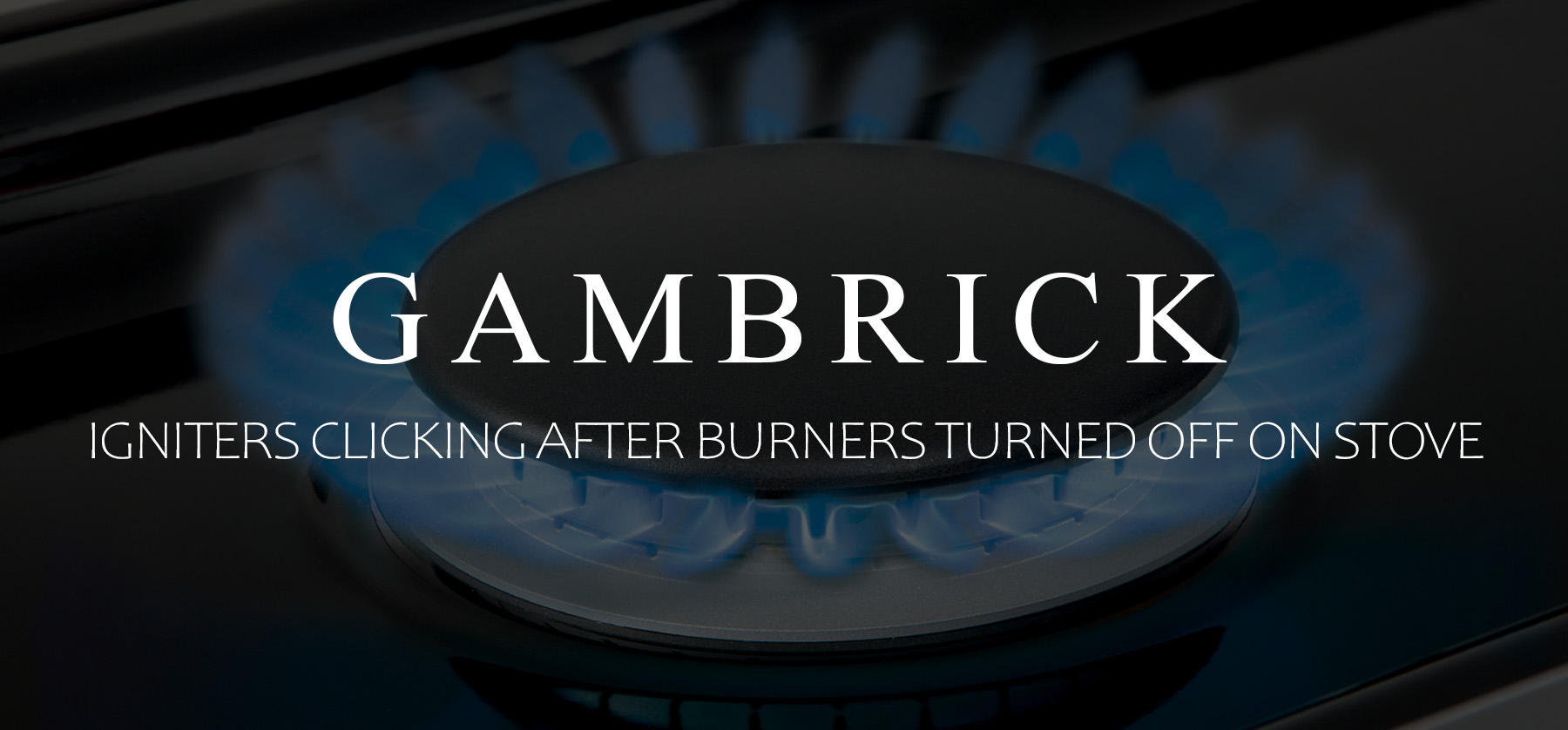Igniters Clicking After Burners Turned Off On Stove
There are several reasons why gas stove igniters can keep clicking after the burners are turned off. The most common are clogged fuel ports, a problem with the burner cap, an issue with the ignition system, or moisture. Luckily, all of these issues are easy to troubleshoot and fix as a DIY project without the need for a repairman.
- Clean around the igniter with a small brush; an old toothbrush works great for this. Use a paperclip or sewing needle to unclog the fuel ports.
- Replace the burner cap.
- Realign the burner cap. If the cap is misaligned, it can cause a clicking sound when the burners are shut off.
- Clean the stove’s ignition system. Food particles and grease can get stuck in these systems and cause the stove to click continuously.
- Dry the burner cap and igniters of all moisture.
When you turn on your stove burners, they should click as the burner lights. This is the sound of your igniters firing, which is what ignites the gas. Once the burner is lit, the clicking should stop when the igniter stops firing.
If the clicking sound continues after the burner is lit or turned off, it’s an igniter that’s continuing to fire.
Even though your igniters are clicking after the stove’s burners are turned off, the burners won’t light without gas. However, you should troubleshoot and fix the issue right away. If someone accidentally bumps the knob and some gas comes out while the igniters are clicking, a burner could turn on.
Several factors can cause igniters to fire and click after you’ve turned off the burner. In this article, I’ll explain how to troubleshoot each potential cause and how to fix it.
How To Stop A Clicking Igniter When The Burner Is Turned Off
That clicking sound you hear when turning on a stove burner is the igniter. When you turn the burner knob, gas flows out of the range’s ignition system, which is lit by the igniter. Every time the igniter sparks, it makes a clicking sound. When a stove is working properly, the igniter stops clicking as soon as the burner is lit or turned off. However, if you hear a clicking sound after the burner is turned off, it means your igniter is still firing.
There are several reasons why an igniter will continue to click after a stove burner is turned off, and each cause has its own fix.
In the sections below, I’ll explain why an igniter won’t stop clicking, how to troubleshoot the cause, and how to fix it.
Food Debris Causing Stove Burner Igniters To Click When Off
If your stove or cooktop burner igniters won’t stop clicking after you’ve turned off the burners, you could have an issue with food debris. This is one of the most common reasons why igniters keep clicking after the burners are switched off. It’s also one of the easiest to troubleshoot and resolve with basic cleaning.
To troubleshoot the problem, inspect your stove’s igniters, around the burner, and under the knobs. Look for signs of built-up gunk and food particles.
Over time, food particles can become trapped around the burner’s ignition system. This disrupts how the system functions, which can cause the igniters to click when the burner knob is turned off.
Luckily, all you have to do is clean the igniters:
- Unplug the range so the igniters stop firing.
- Remove the burner cap.
- Use a toothbrush, small scrubber, or small bristle brush to dislodge and remove food debris:
- Around the burner.
- Under the knobs.
- Around the igniter.
- To eliminate any remaining buildup, gently rub the affected areas with a Q-Tip dipped in alcohol.
- Replace the burner cap.
- Plug the range back in and test out your burners.
Once you’ve thoroughly cleaned the stove’s ignition system, the burners should stop clicking when they’re turned off. However, if they continue to click, there’s another issue.
Excess Moisture Causing Igniter Clicking When Off
Constant igniter clicking can be caused by excess moisture in the vicinity of the igniters. If you cook with sauces or boil water on your stovetop, spills can happen. This moisture can seep towards the igniters, which can cause them to fire and click when the stove burners are turned off.
Cleaning the stove can also leave behind moisture on the stove’s ignition system. If you’ve recently cleaned your cooktop and now the burners won’t stop clicking when the stove is turned off, excessive water or cleaning solution may have seeped into the igniter system.
To fix the problem, let the components dry out before turning on the stove.
Here’s what you should do:
- Unplug the range so the igniters stop clicking.
- Remove knobs and burner caps.
- Raise the stovetop.
- Absorb excess moisture with a paper towel.
- Allow the igniters to air out for a few hours.
- Replace the stove parts you removed.
Once the igniters are completely dry and all the stove parts are re-installed, plug the range back in and test out your burners. If moisture was the issue, the clicking sound will stop when you turn the burners off.
Misaligned Burner Cap Causing Igniters To Click When Off
A misaligned burner cap can cause the igniters to fire when the burner is turned off, which creates a clicking sound. If the position of the cap interferes with the igniter, it could cause it to spark and click.
Luckily, realigning the burner cap is very easy to do and can fix the problem.
Here’s how to do it:
- Unplug the range so the burners stock clicking.
- Make sure the stove is cool.
- Remove the burner grate.
- Take off the burner cap and carefully replace it in the correct position. The cap is designed to naturally fall into the correct position above the flame.
Once the cap is in place, plug the range back in and turn on the burner, then turn it off. If a misaligned cap was the problem, the clicking sound should stop once the burner is turned off.
Igniters Clicking When Off Due To Faulty Parts
Your stove igniters could keep clicking even after the burners are turned off due to a faulty or malfunctioning part. If you continue to hear your igniters clicking when the burners are off after you’ve cleaned them, checked the burner cap, and dried them, you probably have a defective ignition part.
Stove ignition parts aren’t that hard to replace if you’re handy and like DIY projects. Typically you can buy the parts you need online on Amazon, eBay, or through a supply house.
If you suspect you need a new part, contact the manufacturer or the retailer that sold you the stove. If your range is still under warranty, you may be able to get the parts for free.
The parts that typically cause the igniters to spark after the burners are off are:
- Spark Module
- Spark Ignition Switch
- Ignitor
When making repairs to the ignition system of your stove, make sure to unplug it first, or you could get a shock. Once the faulty part is removed and replaced, plug the stove back in and test the burner, you shouldn’t hear a clicking sound when you turn the burner off.
If you’d rather have a professional make the repairs for you, it’s typically around $100-$150 for parts and labor. Changing parts can be done in less than 20 minutes.
How To Clean Your Stove’s Ignition System
If your stove’s ignition system becomes dirty with sauces, grease, grime, or food particles, it can cause a clicking sound when the stove is turned off. The clicking you hear is the sound of your stove’s igniters firing. When the stove is clean and working properly, the igniters should only fire and click when you try to light a burner. However, if they get dirty, they can fire at random times, even when the burners are turned off.
To fix the problem, clean your stove’s entire ignition system thoroughly. All you need is a bristle brush or an old toothbrush, a Q-tip, some alcohol, and some paper towels.
Here’s how to do it:
- Turn off your stove and disconnect it from the power source, even if it’s a gas range.
- Remove each burner cap and scrub around the igniter. An old, dry toothbrush or any small brush will work.
- Unclog the fuel ports using a thin object like a paperclip.
- Clean any grease or residue with rubbing alcohol. You can use a Q-tip for precise cleaning.
- Replace the burner cap, reconnect your stove, and test the burners to see if the clicking stops.
Repeat the cleaning process about every three months if you use your stove regularly. Regular cleanings help maintain a fresh and clean ignition system that won’t click when you turn the burners off.
How To Replace A Burner Cap
A common reason why a stove’s igniters may fire when the burners are turned off, which creates the clicking sound, is a misaligned burner cap. When you remove the caps to clean your ignition system, or if you accidentally bump them while cooking, they could become misaligned.
When you position the burner cap, make sure the burner cap fully covers the entire surface of the ignition system. The cap should naturally fall into place by itself, but you can still make small adjustments to get it into the best position.
Inspect the burner cap for any gaps, bends, or irregularities that could prevent it from fitting snugly on top. If you notice any issues, it could be the reason your stove keeps clicking.
A misshapen burner cap can cause the gas stove’s igniter to spark continuously, even when it’s turned off.
In this case, you have two options:
- Re-center the burner cap over the ignition system to ensure complete coverage.
- Fully replace the burner cap if it is misshapen and can’t be properly adjusted.
If your stove is fairly new and still under warranty, you may be able to get a new burner cap from the manufacturer for free. To find out, contact the manufacturer or the retailer you bought the stove from.
Why Does My Electric Stove Keep Clicking?
Many electric stoves produce periodic clicking sounds while in use, which is considered normal. It’s also common for the stove to click briefly when initially turned on and during the cooling-down phase after it’s turned off. However, constant clicking noises from an electric stove could indicate a more serious issue.
Potential Signs of Trouble
- Constant Clicking:
- A continuous clicking noise suggests that the stove is attempting to heat something, even when it’s turned off.
- It could also indicate an electrical malfunction within the system.
- Fire and Safety Hazard:
- These abnormalities pose significant fire and safety hazards.
Prompt Action is Crucial
If your electric stove is constantly making clicking sounds, address the issue immediately.
- Cease Use: Stop using the stove to prevent any potential risks.
- Unplug: Unplug the stove to stop it from clicking.
- Professional Inspection: Contact a qualified technician or electrician to examine and diagnose the problem.
- Fire and Safety Concerns: Electrical malfunctions can lead to dangerous situations, so get the stove checked out as soon as possible.
How Do I Know If My Stove’s Spark Module Is Bad?
A gas stove’s spark module is what creates the spark that ignites the gas to create a flame. If your stove has no ignition, an inconsistent spark, is continuously clicking, or doesn’t make a clicking sound, you could have a bad spark module.
Here are some ways to diagnose a bad spark module:
- No Ignition: The burners on your gas stove or cooktop may fail to ignite when you turn the knob, despite hearing the clicking sound of the igniters.
- Inconsistent Sparking: If the spark module is malfunctioning, you may observe inconsistent or weak sparking when trying to ignite the burners.
- Continuous Clicking: A defective spark module could result in the igniters continuously clicking even after the burner is turned off.
- No Clicking Sound: On the other hand, if there is no clicking sound at all when you try to ignite the burners, it could indicate a problem with the spark module.
If you experience any of these signs, you have two options, contact a repairman or replace the module yourself. I’ve replaced spark modules several times, and it’s an easy DIY project that only takes about 10-15 minutes. There are several videos online that will show you how to do it.
However, if you’d rather hire a Pro, it usually costs around $200-$350 because the part costs between $50-$200.
How Do You Replace An Ignition Switch On A Gas Stove?
A bad ignition switch can potentially cause your stove’s igniters to fire and click even when the burners are turned off. If your ignition switch has gone bad, there’s no way to fix the issue without replacing the switch. Luckily this is a fairly easy DIY project to complete.
To replace an ignition switch on a gas stove, follow these steps:
- Safety First: Make sure the stove is turned off and disconnected from the power source to prevent any accidents.
- Access the Ignition Switch: Remove the burner grates and burner caps to gain access to the ignition switch. Depending on your stove model, you may need to lift the stovetop or remove a control panel to reach the switch.
- Disconnect Wires: Carefully disconnect the wires connected to the old ignition switch. Take note of their placement or consider taking a photo for reference during reassembly.
- Remove the Old Ignition Switch: Unfasten any screws or clips securing the ignition switch in place. Once loose, carefully pull out the old switch.
- Install the New Ignition Switch: Insert the new ignition switch into the designated slot, ensuring it is properly aligned. Secure it in place with screws or clips.
- Reconnect Wires: Attach the wires to the corresponding terminals of the new ignition switch. Double-check that each wire is correctly connected.
- Reassemble the Stove: Put the burner caps, burner grates, stovetop, or control panel back in their original positions.
- Test the New Ignition Switch: Plug in the stove, turn on the gas, and test the new ignition switch by turning the knobs to ignite the burners. Ensure that the sparking is consistent and the burners light up properly.
Why Does My Stove Click But No Spark?
If you encounter a situation where you turn on your burner, but it doesn’t light, and you hear a clicking noise, it’s usually a dirty burner cap or igniter.
Here are a few steps you can take to troubleshoot the issue:
- Prepare Alcohol and Cotton Swabs: Soak a cotton swab in alcohol, which will be used for cleaning the igniter, and have another cotton swab ready for cleaning the metal burner cap.
- Clean the White Porcelain Igniter: Thoroughly clean the white porcelain igniter by gently rubbing it with the alcohol-soaked cotton swab. Make sure to remove any dirt, grime, or debris that may be hindering the igniter’s functionality.
- Clean the Metal Burner Cap: Similarly, use the cotton swab to clean the metal burner cap. This step ensures that any buildup or blockage on the cap is eliminated.
- Try the Burner Again: After cleaning both the igniter and the burner cap, give it another try. Turn on the burner and listen for any clicking noise. Hopefully, with the improved cleanliness, the burner will ignite properly this time.
Summary: Igniters Clicking After Burners Turned Off On Stove
There are several reasons why gas stove igniters can keep clicking after the burners are turned off. The most common are clogged fuel ports, a problem with the burner cap, an issue with the ignition system, or moisture. Luckily, all of these issues are easy to troubleshoot and fix as a DIY project without the need for a repairman.
- Clean around the igniter with a small brush; an old toothbrush works great for this. Use a paperclip or sewing needle to unclog the fuel ports.
- Replace the burner cap.
- Realign the burner cap. If the cap is misaligned, it can cause a clicking sound when the burners are shut off.
- Clean the stove’s ignition system. Food particles and grease can get stuck in these systems and cause the stove to click continuously.
- Dry the burner cap and igniters of all moisture.
When you turn on your stove burners, they should click as the burner lights. This is the sound of your igniters firing, which is what ignites the gas. Once the burner is lit, the clicking should stop when the igniter stops firing.
If the clicking sound continues after the burner is lit or turned off, it’s an igniter that’s continuing to fire.
Even though your igniters are clicking after the stove’s burners are turned off, the burners won’t light without gas. However, you should troubleshoot and fix the issue right away. If someone accidentally bumps the knob and some gas comes out while the igniters are clicking, a burner could turn on.
If you have any questions or comments about why your stove igniters are clicking after the burners have been turned off, email any time.





















